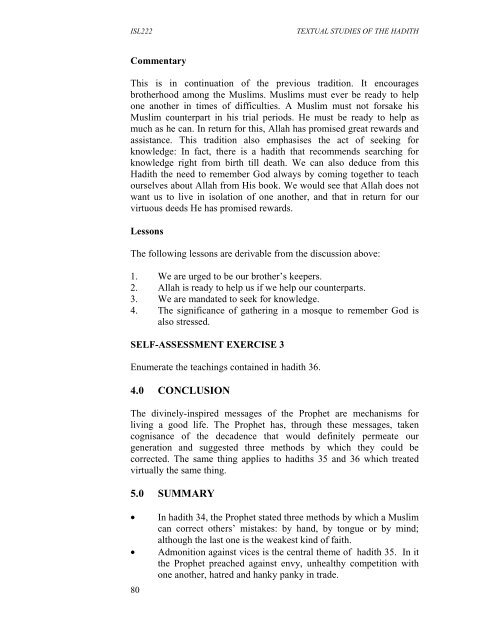Textual Studies of the Hadith - National Open University of Nigeria
Textual Studies of the Hadith - National Open University of Nigeria
Textual Studies of the Hadith - National Open University of Nigeria
You also want an ePaper? Increase the reach of your titles
YUMPU automatically turns print PDFs into web optimized ePapers that Google loves.
ISL222 TEXTUAL STUDIES OF THE HADITH<br />
Commentary<br />
This is in continuation <strong>of</strong> <strong>the</strong> previous tradition. It encourages<br />
bro<strong>the</strong>rhood among <strong>the</strong> Muslims. Muslims must ever be ready to help<br />
one ano<strong>the</strong>r in times <strong>of</strong> difficulties. A Muslim must not forsake his<br />
Muslim counterpart in his trial periods. He must be ready to help as<br />
much as he can. In return for this, Allah has promised great rewards and<br />
assistance. This tradition also emphasises <strong>the</strong> act <strong>of</strong> seeking for<br />
knowledge: In fact, <strong>the</strong>re is a hadith that recommends searching for<br />
knowledge right from birth till death. We can also deduce from this<br />
<strong>Hadith</strong> <strong>the</strong> need to remember God always by coming toge<strong>the</strong>r to teach<br />
ourselves about Allah from His book. We would see that Allah does not<br />
want us to live in isolation <strong>of</strong> one ano<strong>the</strong>r, and that in return for our<br />
virtuous deeds He has promised rewards.<br />
Lessons<br />
The following lessons are derivable from <strong>the</strong> discussion above:<br />
1. We are urged to be our bro<strong>the</strong>r’s keepers.<br />
2. Allah is ready to help us if we help our counterparts.<br />
3. We are mandated to seek for knowledge.<br />
4. The significance <strong>of</strong> ga<strong>the</strong>ring in a mosque to remember God is<br />
also stressed.<br />
SELF-ASSESSMENT EXERCISE 3<br />
Enumerate <strong>the</strong> teachings contained in hadith 36.<br />
4.0 CONCLUSION<br />
The divinely-inspired messages <strong>of</strong> <strong>the</strong> Prophet are mechanisms for<br />
living a good life. The Prophet has, through <strong>the</strong>se messages, taken<br />
cognisance <strong>of</strong> <strong>the</strong> decadence that would definitely permeate our<br />
generation and suggested three methods by which <strong>the</strong>y could be<br />
corrected. The same thing applies to hadiths 35 and 36 which treated<br />
virtually <strong>the</strong> same thing.<br />
5.0 SUMMARY<br />
• In hadith 34, <strong>the</strong> Prophet stated three methods by which a Muslim<br />
can correct o<strong>the</strong>rs’ mistakes: by hand, by tongue or by mind;<br />
although <strong>the</strong> last one is <strong>the</strong> weakest kind <strong>of</strong> faith.<br />
• Admonition against vices is <strong>the</strong> central <strong>the</strong>me <strong>of</strong> hadith 35. In it<br />
<strong>the</strong> Prophet preached against envy, unhealthy competition with<br />
one ano<strong>the</strong>r, hatred and hanky panky in trade.<br />
80

















